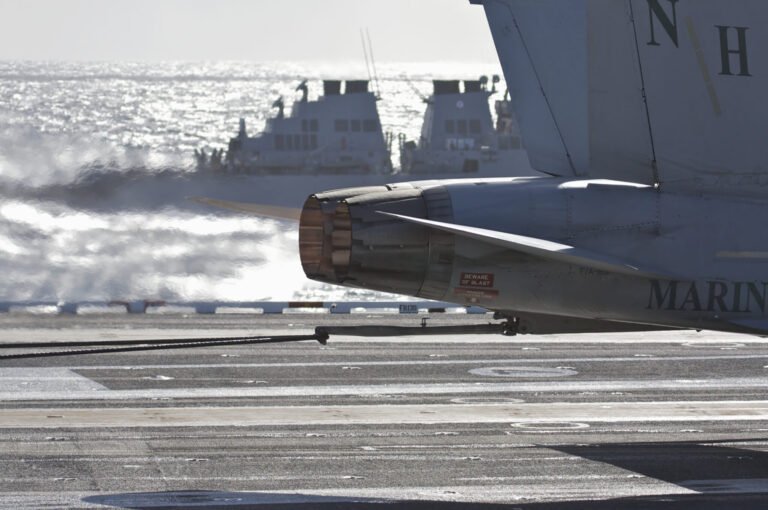
[ad_1]
EXPERT PERSPECTIVE – Following latest Russian airstrikes on Kyiv, Germany despatched the primary of 4 deliberate IRIS-T SLM air protection techniques to Ukraine. France, the UK and the Netherlands all promised to hurry up new air protection system packages. And the US has now delivered just a few items of National Advanced Surface-to-Air Missile System, often known as NASAMS.
As Kyiv requires air protection techniques to counter Russian strikes, others are additionally assessing their missile protection techniques. Latvia has requested NATO to ascertain a missile protect over the Baltic states to bolster the alliance’s jap flank towards potential Russian assaults. Fifteen NATO allies just lately pushed this additional by signing a letter of intent to develop a German-led missile protect over Europe below the “European Sky Shield Initiative.” Within the Center East, Israel and plenty of Arab nations have thought-about joint missile defenses towards potential Iranian assaults. Israel’s latest sale of advance air protection techniques to the United Arab Emirates underscores the brand new urgency to handle this menace.
The US has additionally expressed concern over heightened missile threats. The Biden administration’s just lately launched Missile Defense Review (MDR) focuses on the cruise missile menace, highlighting heightened dangers with the event of hypersonic know-how. Along with regional threats in Europe and the Center East towards US abroad navy bases and allies, the MDR additionally notes threats to the homeland.
BACKGROUND
- A July report from the CSIS Missile Protection Challenge Workforce entitled “North America is a Region, Too,” centered on the homeland menace. The report warns {that a} long-term homeland missile protection is probably going far-off as a result of points with integration into the broader missile protection portfolio and lack of sensor protection.
- The US navy has acquired comparatively modest assist for growing cruise missile protection techniques and coverage, particularly for the US homeland. Funding for cruise missile protection is often added to so-called want lists slightly than being included in base price range requests. There may be additionally ambiguity on the specified scope of cruise missile defenses. The Pentagon additionally solely just lately designated the Air Force to be the acquisition authority for homeland cruise missile defenses following years of bureaucratic logjam on the matter.
- Previous US protection doctrine prioritized wider strategic nuclear deterrence because it assumed cruise missile assaults can be coupled with nuclear assaults. Nevertheless, with the rise of precision-guided missiles, new stealth capabilities and hypersonic know-how, this assumption is being challenged. Extra navy planners are expressing concern that China or Russia might launch an assault beneath the nuclear threshold, thus making correct cruise missile defenses necessary.
- There may be motion by Congress and the US navy to handle the cruise missile protection hole. North American Aerospace Protection Command (NORAD) and US Northern Command (NORTHCOM) say they’re working on a design framework for cruise missile defenses within the US homeland. NORTHCOM can be in search of $278 million for brand spanking new over-the-horizon radars and practically $1 billion for cruise and ballistic missile defenses for Guam for the 2023 fiscal yr. Likewise, Senate’s model of the FY23 Nationwide Protection Authorization Act consists of one other $50.9 million for cruise missile defenses.
THE EXPERTS
The Cipher Transient tapped two former NATO Supreme Allied Commanders, Admiral James Stavridis (Ret.) and Normal Phil Breedlove (Ret.); former Vice Chairman of the US Joint Chiefs of Workers, Admiral James ‘Sandy’ Winnefeld; and Stanton Senior Fellow within the Nuclear Coverage Program on the Carnegie Endowment for Worldwide Peace Ankit Panda for a wide-range professional perspective on the state of US cruise missile defenses and the way finest to enhance them.
Admiral James ‘Sandy’ Winnefeld, Former Vice Chairman, Joint Chiefs of Workers

Cipher Transient Professional Admiral James ‘Sandy’ Winnefeld served for 37 years in the USA Navy. He retired in 2015 after serving 4 years because the ninth Vice Chairman of the Joint Chiefs of Workers and the USA’ quantity two rating navy officer.
Admiral James Stavridis, Former Supreme Allied Commander, NATO

Cipher Transient Professional Admiral James Stavridis was the 16th Supreme Allied Commander at NATO and the 12th Dean of the Fletcher College of Regulation and Diplomacy at Tufts College. He’s at present Vice Chair, World Affairs and Managing Director at The Carlyle Group and Chair of the Board of the Rockefeller Basis.
Normal Philip M. Breedlove, Former Supreme Allied Commander, NATO

Normal Philip M. Breedlove retired because the Commander, Supreme Allied Command, Europe, SHAPE, Belgium and Headquarters, U.S. European Command, Stuttgart, Germany. He served in a number of senior workers positions together with Vice Chief of Workers of the U.S. Air Pressure; Senior Army Assistant to the Secretary of the Air Pressure; and Vice Director for Strategic Plans and Coverage on the Joint Workers.
Ankit Panda, Stanton Senior Fellow within the Nuclear Coverage Program on the Carnegie Endowment for Worldwide Peace

Ankit Panda is the Stanton Senior Fellow within the Nuclear Coverage Program on the Carnegie Endowment for Worldwide Peace. Panda can be editor-at-large on the Diplomat. He’s an professional on the Asia-Pacific area with analysis pursuits starting from nuclear technique, arms management, missile protection, nonproliferation, rising applied sciences and US prolonged deterrence.
Professional Perspective
The Cipher Transient: The place does the US face a severe menace from using cruise missiles?
Stavridis: When it comes to staging defenses towards, for instance, sea-launched cruise missiles, it will appear prudent to start by defending main cities, massive navy complexes, and naturally the capital of the USA.
Winnefeld: Almost certainly within the Center East, the place Iran has not hesitated to strike American troops hosted by our regional companions, particularly given its resolve to avenge the dying of Qasem Soleimani. U.S. troops may be collateral harm from an Iranian strike on a bunch nation itself, akin to Iran’s assaults on Saudi Arabian oil infrastructure.
Panda: The Military’s major concentrate on cruise missile is for Guam, the place there are issues about rising threats from China probably in a future Indo-Pacific battle. An Iron Dome unit is deployed briefly on Guam and is present process testing and analysis.
Breedlove: There are fast threats in Europe, at European bases. We used to have the Intermediate-Vary Nuclear Forces (INF) Treaty and it coated a complete vary of issues. We don’t have the INF anymore.
Additionally, the cruise missile drawback from submarine launch platforms on our coasts is a really actual drawback. We should not have the type of radars we have to defend towards a cruise missile assault,… nor the numbers to guard both our West coast or our East coast. These are massive, massive locations, and our radars are pretty restricted in vary. The large, over the horizon radars, take a look at medium and excessive altitude airplanes, that’s a special drawback. However sea skimming cruise missiles are exhausting to see on the coasts. We’ve checked out techniques just like the JLENS, techniques that grasp in balloons and different issues to attempt to get imaginative and prescient down in order that we are able to see cruise missiles.
The Cipher Transient: What are the most important challenges the US faces in growing cruise missile defenses? Is there a scarcity of developed capabilities, points with integration or lack of technique?
Stavridis: As know-how matures and cruise missiles grow to be extra stealthy, increased pace (into the hypersonic zone), miniaturized, and carrying superior explosive masses – they’re merely way more harmful and tough to defend towards.
Winnefeld: The U.S. possesses subtle cruise missile protection functionality within the type of Patriot and the NASAMS techniques. These techniques will solely enhance with the introduction of the Decrease Tier Air and Missile Protection System (or LTAMDS), which is a alternative for present Patriot radar techniques (Disclosure: I’m on the board of Raytheon Applied sciences, which produces all three techniques).
Nevertheless, these defensive techniques are costly relative to the threats they’re designed to counter and are efficient at pretty quick ranges towards extraordinarily low altitude threats (and thus have a comparatively constrained defended space footprint). Furthermore, as cruise missiles (significantly anti-ship cruise missiles) enhance in sophistication, and are mixed with ballistic missile assaults, they are going to be more durable to counter. Given present know-how, the difficulty is much less technique than it’s useful resource constraints — there are merely not sufficient techniques to go round.
Panda: An enormous problem with cruise missile protection is on the sensor aspect: not like ballistic missiles, cruise missiles stay completely throughout the Earth’s environment and are difficult to trace with space-based sensors. Radars will typically solely detect cruise missiles late of their flight, making space defenses of the sort the U.S. pursues for homeland ballistic missile protection infeasible at acceptable prices. NORAD and NORTHCOM have explored numerous cruise missile protection architectures and this continues to be a spotlight.
Breedlove: The very first thing is detecting them. Hitting a ballistic missile, which is nearly fully predictable, is way simpler than hitting a cruise missile, which flies low and due to this fact is more durable to see. Additionally, nearly all cruise missiles maneuver. Sensing and having the ability to interact a cruise missile is an especially exhausting kinetic drawback.
The Cipher Transient: Because the US works on a permanent cruise missile protection resolution, what ought to it prioritize?
Stavridis: Iron Dome and different such techniques may be useful however over time, it appears inevitable that we’ve got to maneuver towards efficient laser techniques for pace and talent to beat swarms of missiles.
Winnefeld: A great begin can be to obtain extra launcher techniques and guarantee we’ve got sufficient interceptors to handle perceived worst-case demand, each abroad and domestically (see my disclaimer above). As everyone knows, capability has a functionality all its personal. That stated, the U.S. ought to give precedence to growth of directed power techniques, particularly excessive powered microwaves (HPM), designed to counter cruise missile threats, each ashore and at sea. In contrast to lasers (that are largely efficient towards close-in threats akin to unmanned aerial techniques), HPM techniques really don’t require a lot energy (opposite to commonly-held perception, as a result of their extraordinarily quick burst lengths), have an infinite journal measurement (so long as energy is out there), are simpler than lasers in mud and poor climate, and don’t require dwell time on a goal with the intention to render it ineffective. They need to be a developmental precedence, and used at the side of present kinetic techniques.
Panda: My sense is that cruise missile protection ought to concentrate on level defenses for crucial navy amenities and fewer on the homeland mission, which doesn’t strike me as being price efficient or possible.
Breedlove: It is a step-by-step factor. We’ve obtained to see it. And that’s not going to be achieved by the sort and variety of radars that we’ve got proper now. We’re going to need to have one thing like a JLENS, or we’re going to need to have one thing in orbit, we’d like one thing that appears down if we anticipate to see it at a spread that enables engagement. After which a extremely manuevering goal goes to take a extremely maneuvering and succesful interceptor.
The Cipher Transient: Do you suppose the US has been prioritizing ballistic missile defenses over cruise missiles? Is that this an comprehensible growth?
Panda: The U.S. has traditionally prioritized ballistic missile protection—particularly for the reason that Nationwide Missile Protection Act of 1999 and the 2002 exit from the Anti-Ballistic Missile Treaty. This was a perform of the anticipated missile threats on the time to the U.S. homeland and to deployed U.S. forces.
Stavridis: We have now been very centered in fact on ballistic missiles which for many years have been the best menace; however in an period of superior hypersonic nuclear tipped cruise missiles we’re underweight in our capacity to defend.
Breedlove: We’re fearful about ballistic missiles as a result of that has been the menace as a result of their intercontinental functionality. That’s not simple both, by the way in which, simply due to pace. They’re not maneuvering, however the pace they’re getting into makes an intercept actually exhausting. So we’ve been engaged on that as a result of that’s the place nearly all of the throw weight of Russia is. However Russia and China at the moment are shifting in direction of cruise missiles due to all the issues. They know the issues, they’ve them. They’ve the identical factor defending them towards ours.
Winnefeld: The U.S. has been enhancing its cruise missile protection functionality on the identical time it has developed ballistic missile defenses. Once more, this can be a drawback extra associated to capability. From my perspective, nonetheless, we’ve got not carried out sufficient within the realm of homeland protection. We’re weak to a cruise missile assault launched both from Russian lengthy vary bombers or, extra worrisome, from cruise missile carrying submarines off our coast. Warning instances might be too quick for fighter plane to reply from something apart from a steady airborne posture, and even then these belongings want cueing and nearly excellent geometry. Higher to concentrate on level protection techniques, akin to Patriot and HPM techniques, stationed to defend our highest worth authorities, financial, and navy belongings.
Cipher Transient Author Ethan Masucol contributed to this report
Learn extra expert-driven nationwide safety insights, perspective and evaluation in The Cipher Brief
[ad_2]